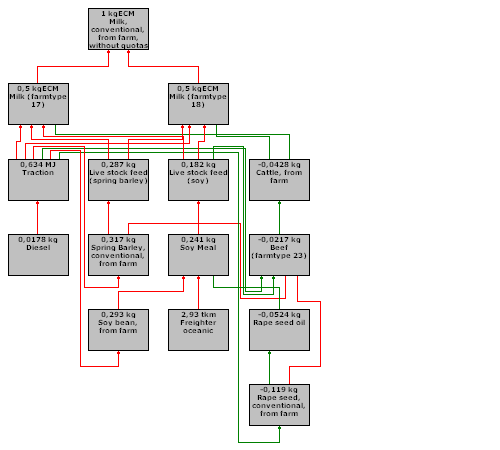Milk ex farm (without quotas)
Milk is produced at dairy farms. The marginal dairy farms cannot be determined based on experience as for other agricultural products because the market has been regulated by quotas for many years (Jensen and Andersen, 2003). However, based on Jensen and Andersen (2003) it has been assumed that the marginal milk is produced at sandy soils at farms with high livestock density (Farm type 17 (50%) and 18 (50%)).
The environmental impacts associated with milk are influenced by the demand for cattle meat because milk- and cattle production are integrated in one process. It has been assumed that the extent of Danish cattle meat production is determined by the milk demand independently of the presence quotas (see cattle).
The main processes influenced by milk demand ex farm are shown in the figure below.
|
|
| Figure 1: Market based product chain diagram for milk ex farm covering the most important processes in terms of contribution to global warming in an envisioned scenario without milk quotas. Boxes refer to production processes. Names of grey boxes refer to the main product of the processes. Red arrows represent material or energy transfer between two processes; green arrows represent saved material or energy transfer as a result of displacements; green lines represent displacements and red lines represent avoided displacements. Further details can be found in the LCA model |
Dairy cows at farm type 17 and 18 are fed with livestock
feed produced from spring barley
and soy meal and
a number of other ingredients of less importance. The milk farms produce
cattle (old dairy cows and bull calves) as a co-product to milk production.
The cattle is slaughtered and the expensive meat (>101
DKK per kg) is assumed to displace cattle meat produced
at extensive cattle farms abroad. Farm type 23 has been used to represent
extensive cattle production abroad (see cattle)
explaining the green lines from the milk farms (17 and 18) and the avoided
beef meat production. Cheap cattle meat (<
101 DKK per kg)
is assumed to
displace cheap pork. Avoided contributions to global warming as a result
of pork displacement are too small to be included in the figure above.
The
assumptions related
to cattle meat's
displacements have not been justified.
The table below shows potential environmental impacts associated with milk demand ex dairy farm in an envisioned market situation without milk quotas. All data are provided per kg milk.
|
Impact category
|
Unit | Ex dairy farm | |
|
Conventional |
Organic |
||
|
Global warming |
g CO2-eq. | 1010 |
|
|
Acidification |
g SO2-eq. | 10.4 |
|
| Nutrient enrichment | g NO3-eq. | 51 | |
| Photochemical smog | g ethene eq. | 0.29 | |
| Land use | m2 year | 1.5 | |
| Location in database: Materials/scenario without milk quotas/food from primary sectors/ Milk/conventional, from farm, without quotas |
